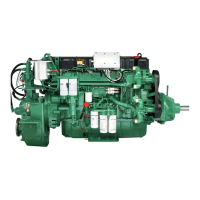D
Group 20
Start and Stop Problems, Fault Tracing
Symptom fault tracing
Depending on the vehicle configuration, conditions
related to start and stop problems may be caused or
influenced by specific faults or malfunctions in other
vehicle components. These include components such as
batteries, bodybuilder adaptations, etc. In such cases,
also refer to the specific Service Information for those
components.
Note: You must read and understand the precautions
and guidelines in Service Information, group 20,
"General Safety Practices, Engine" before performing any
suggested procedures. If you are not properly trained and
certified in a procedure, ask your supervisor for training
before you perform it.
“General Information” page 4
For specific symptoms, see:
•
“Engine Does Not Start” page 5
•
“Engine Difficult to Start” page 5
•
“Engine Starts But Will Not Continue to Run” page 5
•
“Engine Unexpectedly Shuts Down During
Deceleration” page 6
•
“Engine Cuts Out Intermittently” page 6
•
“Engine Does Not Shut Off” page 6
“Symptom, Fault Tracing” page 3
General Information
C2002642
Note: During fault tracing, the engine should be run at
the operating temperature as well as at the temperature
where the symptom occurs.
•
Start or stop problems may be caused by
abnormal engine conditions, including fuel supply,
air inlet/exhaust, or faults related to the engine
management system. Therefore, fault tracing should
be based on components related to those systems.
Fault Tracing
Intermittent faults can be difficult to trace since the fault
may not occur when the vehicle is brought in to be
checked.
Fault tracing should be performed based on what the
driver has experienced. The information that the driver
has provided in conjunction with the gathering of factual
data should form the basis of how the problem should
be resolved.
Whenever possible, try to recreate the problem in an
environment and situation similar to the one described
by the driver.
Begin by determining if anything has recently happened
to the vehicle that could point to the electrical system,
but which does not have anything to do with the engine
control system.
For specific symptoms, see:
4

